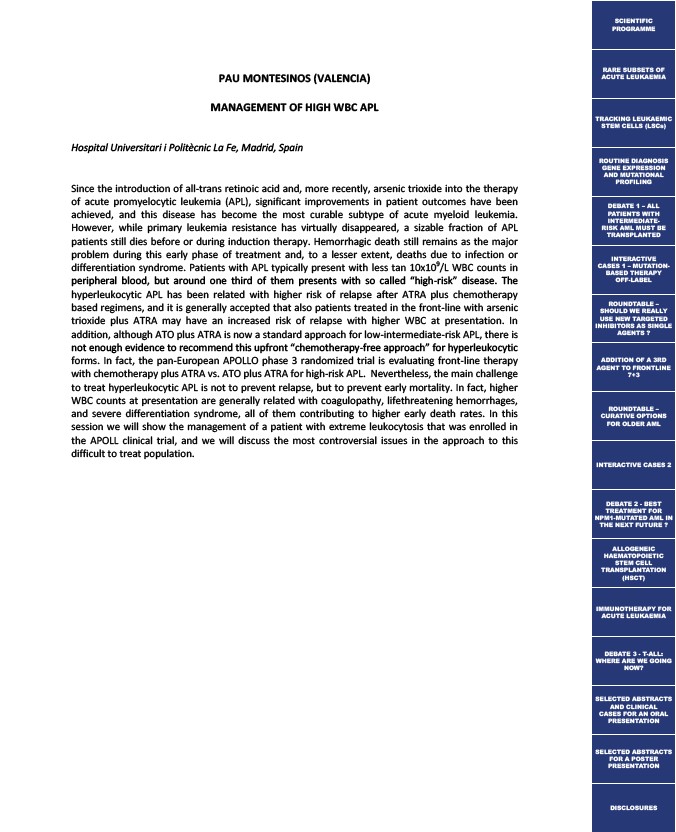
PAU MONTESINOS (VALENCIA)
MANAGEMENT OF HIGH WBC APL
Hospital Universitari i Politècnic La Fe, Madrid, Spain
Since the introduction of all-trans retinoic acid and, more recently, arsenic trioxide into the therapy
of acute promyelocytic leukemia (APL), significant improvements in patient outcomes have been
achieved, and this disease has become the most curable subtype of acute myeloid leukemia.
However, while primary leukemia resistance has virtually disappeared, a sizable fraction of APL
patients still dies before or during induction therapy. Hemorrhagic death still remains as the major
problem during this early phase of treatment and, to a lesser extent, deaths due to infection or
differentiation syndrome. Patients with APL typically present with less tan 10x109/L WBC counts in
peripheral blood, but around one third of them presents with so called “high-risk” disease. The
hyperleukocytic APL has been related with higher risk of relapse after ATRA plus chemotherapy
based regimens, and it is generally accepted that also patients treated in the front-line with arsenic
trioxide plus ATRA may have an increased risk of relapse with higher WBC at presentation. In
addition, although ATO plus ATRA is now a standard approach for low-intermediate-risk APL, there is
not enough evidence to recommend this upfront “chemotherapy-free approach” for hyperleukocytic
forms. In fact, the pan-European APOLLO phase 3 randomized trial is evaluating front-line therapy
with chemotherapy plus ATRA vs. ATO plus ATRA for high-risk APL. Nevertheless, the main challenge
to treat hyperleukocytic APL is not to prevent relapse, but to prevent early mortality. In fact, higher
WBC counts at presentation are generally related with coagulopathy, lifethreatening hemorrhages,
and severe differentiation syndrome, all of them contributing to higher early death rates. In this
session we will show the management of a patient with extreme leukocytosis that was enrolled in
the APOLL clinical trial, and we will discuss the most controversial issues in the approach to this
difficult to treat population.
SCIENTIFIC
PROGRAMME
RARE SUBSETS OF
ACUTE LEUKAEMIA
TRACKING LEUKAEMIC
STEM CELLS (LSCs)
ROUTINE DIAGNOSIS
GENE EXPRESSION
AND MUTATIONAL
PROFILING
DEBATE 1 – ALL
PATIENTS WITH
INTERMEDIATE-RISK
AML MUST BE
TRANSPLANTED
INTERACTIVE
CASES 1 – MUTATION-BASED
THERAPY
OFF-LABEL
ROUNDTABLE –
SHOULD WE REALLY
USE NEW TARGETED
INHIBITORS AS SINGLE
AGENTS ?
ADDITION OF A 3RD
AGENT TO FRONTLINE
7+3
ROUNDTABLE –
CURATIVE OPTIONS
FOR OLDER AML
INTERACTIVE CASES 2
DEBATE 2 - BEST
TREATMENT FOR
NPM1-MUTATED AML IN
THE NEXT FUTURE ?
ALLOGENEIC
HAEMATOPOIETIC
STEM CELL
TRANSPLANTATION
(HSCT)
IMMUNOTHERAPY FOR
ACUTE LEUKAEMIA
DEBATE 3 - T-ALL:
WHERE ARE WE GOING
NOW?
SELECTED ABSTRACTS
AND CLINICAL
CASES FOR AN ORAL
PRESENTATION
SELECTED ABSTRACTS
FOR A POSTER
PRESENTATION
DISCLOSURES